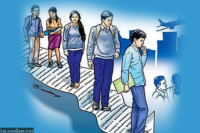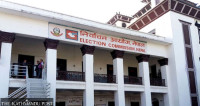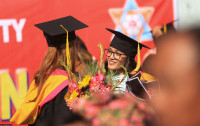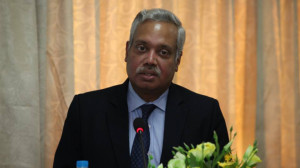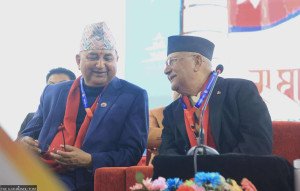National
At Pokhara school, blind students are shifting from Braille to computers
Thirty of the 65 blind students at Amar Singh Secondary School are learning to use computers. Say it is much easier and faster to complete assignments on laptops than using Braille.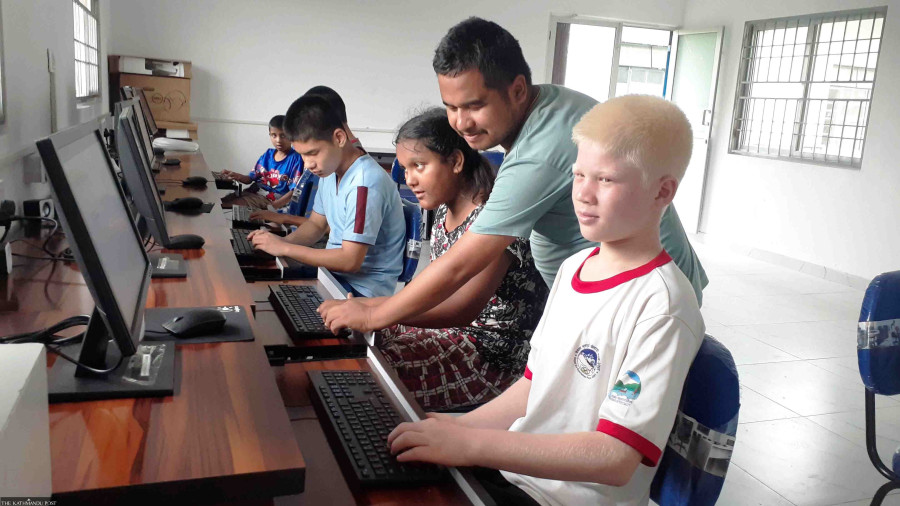
Anup Poudel
Until a year ago, Pratik Pokhrel from Tanahun relied entirely on Braille to read and write. Nowadays, the ninth grader at Amar Singh Model Secondary School in ward 12 of Pokhara Metropolis completes most of his assignments on a laptop. He types his homework, prints it if needed, and submits it to teachers—something he could never do as efficiently with Braille.
“With Braille, papers got lost or erased and I often couldn’t submit on time. Now I can store my work digitally, keep a copy for myself, and hand in a printed version,” said Pokhrel.
Pokhrel is among 65 visually impaired students studying at the school, 47 of whom live in the school hostel. Of them, 30 receive regular computer training. While younger students in grade four and below, as well as those newly admitted in grade eleven, are yet to begin digital learning, most others are gradually shifting from Braille to digital technology.
According to the computer users, computers save both time and effort. “Writing a page in Braille takes seven to eight minutes, while typing the same content on a keyboard takes just three minutes,” Pokhrel explained. He still uses Braille for mathematics, but for almost all other subjects, the computer has become his main tool.
More students including Supreme Paudel, a fourth grader from Syangja and still using Braille, have been learning Nepali and English typing. He says it is preparation for the future. “When I type, the computer speaks what I write. It is exciting,” he said, referring to the screen reader software that converts text into speech.
Computer instructor Chhabi Ale, who teaches the students in four groups based on their levels, says the training includes English and Nepali typing, Microsoft Word, Excel, PowerPoint, and email. “We introduce Braille to students up to grade six, but from grade seven onwards, computer learning is prioritised,” said Ale.
Braille is still mandatory to build writing skills, but students are encouraged to shift gradually to digital tools. “Some senior students now prefer computers over Braille because it is faster and more versatile,” Ale said. He believes that learning computers early can open career opportunities. “Whether a student becomes a government employee, writer or programmer, digital literacy ensures they can make a living.”
Yet, not all students have access to personal devices. Many come from poor families who cannot afford laptops. “Some students even ask us to tell their parents, but not every family can buy one,” Ale said. He suggests that local governments could step in. “If each ward supported even one or two visually impaired students, spending around Rs200,000, their future could be transformed.”
Visually impaired students use computers equipped with screen reader software. The programme converts text, numbers, and symbols on the screen into speech, which students listen to through speakers. Since they cannot use a mouse, they rely entirely on keyboard shortcuts.
At the Ramghat-based school, which has taught visually impaired students since 1981, computer training began only six years ago. The results, according to the chief of the school's Department of the Visually Impaired, Naresh Nepal, have been encouraging. “Students find it easier to connect with technology, though [English] language remains a barrier,” he said. “Many study in Nepali medium until grade eight, so switching to English while using digital platforms is a challenge. Still, when it comes to mobile or computer use, they quickly catch on.”
The school has around 2,700 students up to grade twelve, including 65 visually impaired learners who study in inclusive classrooms alongside sighted peers. Among them, 41 still rely on slate and stylus to write in Braille, while 23 with partial vision use print letters. One student uses both.
Teachers face difficulties evaluating Braille assignments since most cannot read them. To solve this, the school has employed two staff members dedicated to transcribing Braille into print. Only after transcription can teachers grade the work. This process is time-consuming and delays feedback.
“Real-time response is difficult with Braille,” said Ale. “If students learn to type, they can print their work and submit it directly. That makes learning faster and examinations more practical,” he asserted.
While Braille remains an essential foundation, teachers and administrators agree that technology will play a central role in the future of education for visually impaired students. “It is only a matter of time before digital tools become standard in classrooms and exams,” Ale said.
For students like Pokhrel, the shift has already made a significant difference. “With computers, I don’t have to depend on anyone to read or write for me,” he said with an air of confidence. “I feel more independent, and I know this skill will help me earn a living someday.”




 18.12°C Kathmandu
18.12°C Kathmandu

%20(1).jpg&w=200&height=120)
